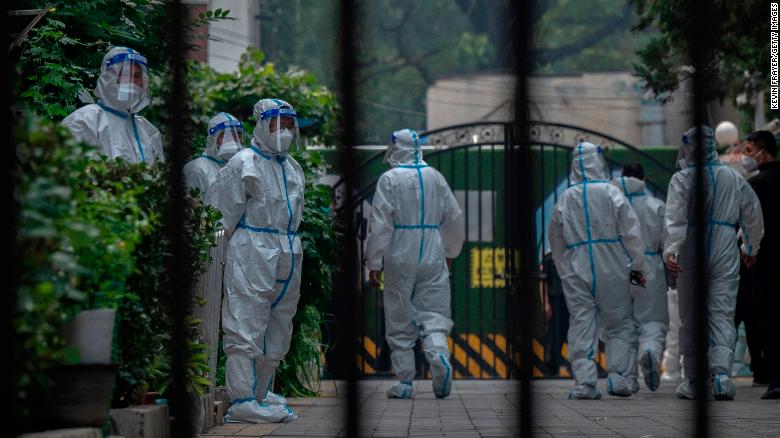
(CNN)Covid patients aren’t directly overwhelming hospitals right now, but ripple effects of the pandemic are keeping beds full and patients away from the care they need.
Most nursing homes are limiting new patients because of staffing shortages, driving the average hospital stay up to be longer than it was pre-pandemic.
In Washington, about 10% of patients currently in hospital beds no longer need hospital care, said Cassie Sauer, chief executive officer of the Washington State Hospital Association. Most are waiting for a spot at a nursing home or mental health facility.
“It’s a national phenomenon,” said Sauer, who has experienced the effects first-hand. A family member’s hospital discharge was delayed after two nursing homes she was interested in closed for Covid outbreaks.
Stephanie Schulz, a board-certified independent patient advocate, said that one hospital she works with recently had 45 patients who all needed to be discharged within the same time frame — and they were struggling to find appropriate care for all of them.
Another patient and their family were considering options that were three hours away from home.
“So many people don’t want to think Covid is still one of the reasons, but it is,” Schulz said.
More than 60% of nursing homes are limiting new admissions because of staffing shortages, according to a survey conducted by the American Health Care Association in May. Most say it’s gotten worse since January.
The pandemic has “made a really difficult job even tougher,” said Mark Parkinson, president and CEO of the American Health Care Association, as employees are faced with “intense work” to prevent the spread of Covid.
Data from the Bureau of Labor Statistics shows that hundreds of thousands of employees have left the nursing home industry since the start of the pandemic.
And now, “hospitals just aren’t able to discharge people like they typically could,” he said. “They’re calling around to the nursing homes, and the nursing homes are saying we just can’t take the patient because we don’t have enough employees to take any patients at this time.”
In fact, patients heading from a hospital to a skilled nursing facility required an average of four referrals in 2019 — but that jumped to an average of seven referrals in the first five months of 2022, according to data shared with CNN by WellSky, a health care technology company with products utilized by hospitals across the country.
Those patients would stay in the hospital for an average of nine days in 2019, but are now in the hospital for an average of 10.5 days, according to the WellSky data.
“Generally speaking, we as a country have worked our tails off to discharge — particularly elective surgeries or pregnancies — much, much quicker, and the level of outpatient surgery has gone through the roof. And yet, here we are in 2022 seeing length of stay balloon up in ways that we’ve never seen, when in fact most of everything we’ve done is to work that number down,” said Bill Miller, chief executive office of WellSky.
“You’re seeing these ballooned rates and Covid is, I think, the primary culprit. It’s still working its way through the system.
Overall in the US, just 4% of beds are in-use by Covid-19 patients as hospitalizations hover at one of the lowest points of the pandemic, according to data from the US Department of Health and Human Services.
But one in five people in the US still lives in a county that the US Centers for Disease Control and Prevention considers to have a “high Covid-19 community level,” where the health care system is at risk of being overwhelmed again.
“We really need to have available capacity if there is another surge. Patients waiting in hospitals take up a lot of unnecessary space and staff time,” Sauer said.
She estimates that hospital stays for Covid patients are about five days, on average. If someone waiting for a spot in a nursing home is in the hospital for more than 10 days, they’re occupying space that two Covid patients could have used — and many stays are much longer than that.
While Covid admissions are low, the persistent strain on the broader health care system is leaving many hospital patients with tough decisions.
As the denials for discharge pile up, “families are feeling like they really have no choice,” Schulz says. They feel trapped in the hospital and like they have to take the first facility that accepts them.
“Those hard decisions do have to sometimes be made to forego certain types of treatment just to get them out of the hospital,” Schulz said — even among patients with a terminal diagnosis.
Discharge delays have a compounding effect, too.
There can be such a gap between the start of discharge planning for a patient and when they find a spot that their care needs change and the process has to start all over again.
“Having reassessments done on level of care includes all disciplines of the health care team. So you’re bringing back in PT, OT, speech therapy, all the providers that are working with those patients,” she said.
And potential exposure to Covid in the hospital requires patients to be held for at least a week, too.
“It’s quite a big domino effect.” she said.
Sauer says the time to make adjustments is now.
“I don’t like that we’re waiting til things get really bad to respond — like the notion that with hospitalizations, we reach a crisis point, then we’ll ask people to take corrective action,” she said.
“There’s delayed care, that’s a phenomenon across the country. And the people who can’t get discharged from hospitals, that’s a phenomenon across the country. And the lack of mental health care is also phenomenon across country. And short staffing. So we know hospitals are stressed,” she said. “I just don’t want to wait til we get to the crisis to do something about it.”




